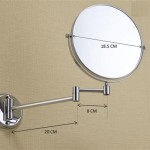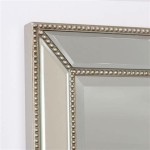How Big Should a Wall Mirror Be?
Mirrors are versatile design elements that can enhance the aesthetics and functionality of any space. They can make a room feel larger, brighter, and more inviting. One of the most crucial considerations when incorporating a mirror into your décor is determining its appropriate size. A mirror that is too small can be insignificant, while one that is too large can overwhelm the space. Choosing the right size mirror requires careful consideration of several factors.
The Size of the Room
The size of the room is the primary factor in determining the appropriate size of a wall mirror. Larger rooms can accommodate larger mirrors, while smaller rooms may require smaller mirrors to avoid feeling cluttered. As a general rule, the mirror should be approximately one-third to one-half the width of the wall or furniture piece it is placed above. For instance, a mirror that is 36 inches wide would be suitable for a wall that is 72 to 108 inches wide. However, these are just guidelines, and the ideal size will ultimately depend on the specific dimensions of the room and the desired effect.
The Focal Point
Mirrors can be used to create a focal point in a room, drawing attention to a particular area. When using a mirror to highlight a specific feature, such as a fireplace, artwork, or a beautiful window, it should be large enough to encompass the focal point and enhance its prominence. For example, a large, ornate mirror placed above a fireplace can create a stunning visual impact. On the other hand, a small mirror above a small piece of artwork may not have the desired effect.
The Style of the Room
The style of the room and the furniture pieces in it should also be considered when choosing a mirror size. In a contemporary room with clean lines and minimalist décor, a large, rectangular mirror can be a perfect complement. In a more traditional setting, an ornate, smaller mirror with a decorative frame may be more appropriate. Therefore, it is crucial to select a mirror that harmonizes with the overall aesthetic of the room and complements the existing furnishings.
The Shape of the Mirror
The shape of the mirror can significantly affect its visual impact. Rectangular mirrors are the most common choice, as they provide a classic and versatile look. Round mirrors can add a touch of whimsy and softness to a space. Oval mirrors offer a more elegant and sophisticated feel. The shape of the mirror should be chosen based on the desired aesthetic and the surrounding décor. For instance, a round mirror can be a great choice for a bathroom or bedroom, while a rectangular mirror might be more suitable for a living room or dining room.
The Height of the Mirror
The height of the mirror is also important to consider. It should be hung at a height that is both aesthetically pleasing and functionally convenient. The general rule of thumb is to hang the mirror so that the center is at eye level, but it is often recommended to hang it slightly higher to create a more balanced and visually appealing arrangement. When hanging a mirror above a piece of furniture, the bottom of the mirror should be approximately 6 to 8 inches above the furniture.
Placement of the Mirror
The placement of the mirror can also influence its effectiveness. Mirrors can be used to reflect light, create the illusion of more space, and add a touch of drama. Placing a mirror opposite a window can help to brighten a room by reflecting natural light. Mirrors placed on a wall that is perpendicular to a window can create a sense of depth and make the room feel larger. When placing a mirror in a hallway or entryway, consider its orientation to avoid creating a dizzying effect.
Additional Considerations
In addition to these key factors, there are several other points to consider when choosing a mirror size. The budget is a major factor. Mirrors come in a wide range of prices, so it is necessary to set a budget before shopping. The weight of the mirror is also important, especially if it is large or heavy. Ensure that the wall can adequately support the weight of the mirror. Finally, take into account the overall design of the room and the placement of other decorative elements. A well-placed mirror, in the appropriate size, can create a dramatic and cohesive look.

A Guide On Using Large Wall Mirrors Majestic Glass

9 Modern Wall Mirrors How To Choose Allisa Jacobs

How Big Should A Bathroom Mirror Be

How To Add A Wood Frame Large Wall Mirror For Under 20 Dream Design Diy
Entryway And Foyer Mirrors Don T Miss Out On This Design Element Abc Glass Mirror

Custom Framed Mirrors Bathroom And Dining Room At Framedart Com

How Big Should Your Bathroom Mirror Be Hastings Tile Bath

Mirror Wall Decor Large Framed Herringbone Handmade Rustic

Studio 350 Contemporary Rectangular Wall Mirror Multiple Finishes And Sizes Black Extra Large 14 W 36 H Com

Should You Put A Mirror In Every Room Of Your Home Giant Glass








